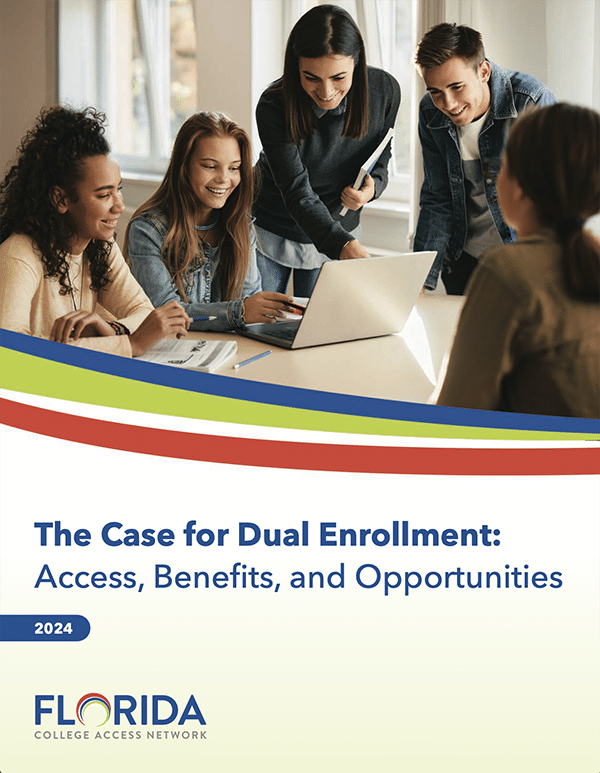~New report recommends policy improvements to drive increased participation in Dual Enrollment courses~
A new report released today by Florida College Access Network makes the case for expanding access to dual enrollment courses in Florida.
Florida’s dual enrollment programs allow eligible middle and high school students to take college-level courses across public and nonpublic postsecondary institutions, which provide a head start to academic and career pathways while reducing financial barriers. Yet, on a course-by-course registration basis, Black students accounted for only 14.7% of dual enrollments and Latino students for 29.9% of dual enrollments, compared to white students who accounted for 46.6% of dual enrollments. These patterns are incongruent with overall school enrollment patterns, according to the most recent data from the U.S. Department of Education.
 In an environment where community college enrollment is steadily in decline and underrepresented students are falling further behind, Florida College Access Network’s new brief untangles the untapped potential of statewide program and offers policy improvements to expand access.
In an environment where community college enrollment is steadily in decline and underrepresented students are falling further behind, Florida College Access Network’s new brief untangles the untapped potential of statewide program and offers policy improvements to expand access.
Nationally, community college enrollment dropped nearly 25% since 2011, according to a recent analysis of IPEDS data from the Community College Research Center (CCRC). While recent high school graduates account for the most significant declines, underrepresented populations continue to face challenges. Interestingly, new data shows dual enrollment programs significantly bolster enrollment rates for all students. New data from the National Student Clearinghouse reveals a 10.6% surge in dual enrollment students under 17-years-old, highlighting a tangible opportunity to reverse declining postsecondary enrollment trends through enhanced dual enrollment policies.
“The full potential of Florida’s dual enrollment programs remains untapped,” said Braulio Colón, executive director for the Florida College Access Network. “We need policy improvements to simplify local implementation and help streamline funding mechanisms for school districts and postsecondary institutions. We also need increased visibility so more students understand the value and can participate.”
The new report suggests dual enrollment expansion is stagnant, in part, because school districts and postsecondary institutions need clear, streamlined processes to expand programs, requiring state guidance and improved policy.
The Case for Dual Enrollment: Access, Benefits, and Opportunities report highlights best practices where school districts and postsecondary institutions have meaningfully enhanced delivery of dual enrollment programs equitably through Accelerated Pathway courses, Collegiate Academy programs dedicated to STEM and health sciences, and strategies that strengthen business partnerships, processes, virtual information sessions and assigned advisors to help students navigate delivery models.
The brief also recommends a policy that would fund dual enrollment delivery at full cost to a single legislative appropriation to postsecondary institutions rather than multiple funding mechanisms that require additional resources and staffing. The report also stresses a need to address the limitations of student eligibility by requiring districts and postsecondary institutions to specify alternate placement methods into their dual enrollment articulation agreement.
Lastly, the brief highlights the collaborative nature of most dual enrollment policies, where local leaders, superintendents, and presidents must shape agreements on their own. Strengthened policy would reduce the reliance of ad hoc relationships and practices.
